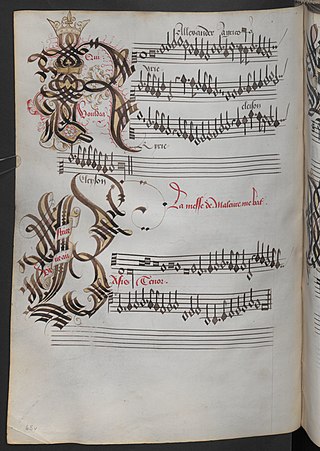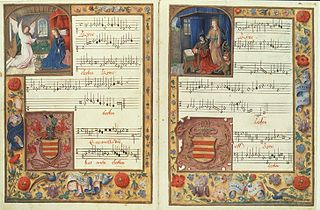Related Research Articles

Josquin Lebloitte dit des Prez was a composer of High Renaissance music, who is variously described as French or Franco-Flemish. Considered one of the greatest composers of the Renaissance, he was a central figure of the Franco-Flemish School and had a profound influence on the music of 16th-century Europe. Building on the work of his predecessors Guillaume Du Fay and Johannes Ockeghem, he developed a complex style of expressive—and often imitative—movement between independent voices (polyphony) which informs much of his work. He further emphasized the relationship between text and music, and departed from the early Renaissance tendency towards lengthy melismatic lines on a single syllable, preferring to use shorter, repeated motifs between voices. Josquin was a singer, and his compositions are mainly vocal. They include masses, motets and secular chansons.

Johannes Ockeghem was a Franco-Flemish composer and singer of early Renaissance music. Ockeghem was the most influential European composer in the period between Guillaume Du Fay and Josquin des Prez, and he was—with his colleague Antoine Busnois—the leading European composer in the second half of the 15th century. He was an important proponent of the early Franco-Flemish School.

Alexander Agricola was a Netherlandish composer of the Renaissance writing in the Franco-Flemish style. A prominent member of the Grande chapelle, the Habsburg musical establishment, he was a renowned composer in the years around 1500, and his music was widely distributed throughout Europe. He composed music in all of the important sacred and secular styles of the time.
Musica ficta was a term used in European music theory from the late 12th century to about 1600 to describe pitches, whether notated or added at the time of performance, that lie outside the system of musica recta or musica vera as defined by the hexachord system of Guido of Arezzo.

The Chigi codex is a music manuscript originating in Flanders. According to Herbert Kellman, it was created sometime between 1498 and 1503, probably at the behest of Philip I of Castile. It is currently housed in the Vatican Library under the call number Chigiana, C. VIII. 234.

Jaap Kunst was a Dutch musicologist. He is credited with coining the term "ethnomusicology" as a more accurate name for the field then known as comparative musicology. Kunst studied the folk music of the Netherlands and of Indonesia. His published work totals more than 70 texts.
Ghiselin Danckerts was a Dutch composer, singer, and music theorist of the Renaissance. He was principally active in Rome, in the service of the Papal Chapel, and was one of the judges at the famous debate between Nicola Vicentino and Vicente Lusitano in 1551.

The Missa L'homme armé super voces musicales is the first of two settings of the Ordinary of the Mass by Josquin des Prez using the famous L'homme armé tune as their cantus firmus source material. The setting is for four voices. It was the most famous mass Josquin composed, surviving in numerous manuscripts and print editions. The earliest printed collection of music devoted to a single composer, the Misse Josquin published by Ottaviano Petrucci in 1502, begins with this famous work.
Marbrianus de Orto was a Dutch composer of the Renaissance. He was a contemporary, close associate, and possible friend of Josquin des Prez, and was one of the first composers to write a completely canonic setting of the Ordinary of the Mass.
Jehan Fresneau was a French composer of the Renaissance. He was one of the composers in the renowned Milan chapel in the mid-1470s, which was disbanded after the assassination of Duke Galeazzo Maria Sforza.

Carel Anton Fodor or Carolus Antonius Fodor was a Dutch pianist, conductor, and the most prominent composer of his generation in the Netherlands, writing in the manner of Joseph Haydn.
Juan García de Basurto (c.1480–1548) was a Spanish composer and cantor of the Cathedral of Tarazona.

Johan van der Meer was a Dutch choral conductor and pioneer in the field of historically informed performance. He founded the Groningse Bachvereniging.
Missa Cuiusvis Toni is a four-part musical setting of the Ordinary of the Mass by the 15th-century composer Johannes Ockeghem. It is found in late-century manuscripts, including the Chigi codex, and was published in 1539, 42 years after the composer's death in 1497.
A royal chapel is a chapel associated with a monarch, a royal court, or in a royal palace.
Johannes Sticheler or Johannes Stickels is a 15th-century composer known primarily from his Missa se j'avoye porpoin de valeur in Vienna, Nationalbibliothek, MS 1 1883. He is possibly the same composer as Jonnes Estiche, known for an Ave Maris Stella and a motet or mass section Et incarnatus est.

Rijnsburg Abbey was a Benedictine nunnery in Rijnsburg, Netherlands, active between 1133 until 1574.

The Tijdschrift van de Koninklijke Vereniging voor Nederlandse Muziekgeschiedenis is a peer-reviewed academic journal covering the music history of the Low Countries. It is published by the Koninklijke Vereniging voor Nederlandse Muziekgeschiedenis and the editor-in-chief is Eric Jas. It was established in 1882 as the Tijdschrift der Vereeniging voor Noord-Nederlandsche Muziekgeschiedenis, renamed "Tijdschrift der Vereeniging voor Nederlandsche Muziekgeschiedenis" in 1909. In 1948 the name was changed again to the more general Tijdschrift voor Muziekwetenschap, but in 1960 this reverted to the previous Tijdschrift van de Vereniging voor Nederlandse Muziekgeschiedenis. The journal obtained its current title in 1995 when the society obtained the right to call itself "Royal". The journal is published in two yearly issues, although these are often combined in one special issue covering a single topic.

Albertus Antonius Smijers, was a Dutch musicologist who served as Professor of Musicology at the University of Utrecht. He was a noted authority on Josquin des Prez—44 volumes of Werken van Josquin des Prez were published in his lifetime, and another 11 after his death.
The Missa ad fugam is a musical setting of the Ordinary of the Mass by the composer Josquin des Prez, dating from the early 16th century.
References
- Leeman Perkins, "Johannes Ockeghem." Grove Music Online, ed. L. Macy (Accessed December 2, 2020), (subscription access)
- Burkholder, J. Peter, et al. A History of Western Music. 9th ed., W. W. Norton & Company, 2014. pp. 191–195.
- Duffin, Ross W. “Mi chiamano Mimi … but My Name is Quarti toni: Solmization and Ockeghem's Famous Mass.” Early Music, May 2001, Vo. 29, No. 2, pp. 164– 180+183-184. Oxford University Press, 2001.
- Godt, Irving. “An Ockeghem Observation: Hidden Canon in the "Missa Mi-Mi?" Tijdschrift van de Vereniging voor Nederlandse Muziekgeschiedenis, 1991, Deel 41, No. 2 (1991), pp. 79–85. Koninklijke Vereniging voor Nederlandse Muziekgeschiedenis (KVNM), 1991.
- Miyazaki, Haruyo. “New Light on Ockeghem's “Missa ‘Mi-mi.’” Early Music, Aug, 1985, Vol. 13, No. 3, pp. 367-375. Oxford University Press, 1985.
- Stewart, Rebecca. “... Ita desiderat anima mea ad te, Deus (Ps.42:1): Johannes Ockeghem, a Most Medieval Musician.” Tijdschrift van de Koninklijke Vereniging voor Nederlandse Muziekgeschiedenis, Deel 47, No. 1/2, Johannes Ockeghem, pp. 163–200. Koninklijke Vereniging voor Nederlandse Muziekgeschiedenis, 1997,